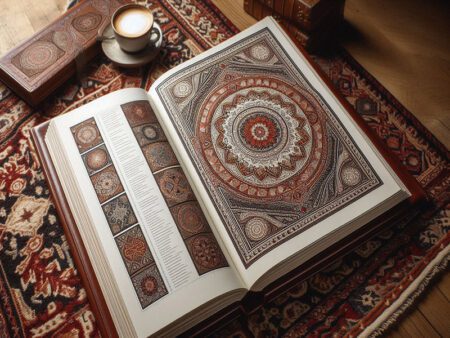
VERNA CARPET – Redesign by Parsineweb





Showing 1–20 of 70 results
What is the history of Tabriz rugs? Where do Tabriz rugs come from? If you are planning to buy Tabriz carpets, it is better to familiarize yourself with their history. Stay with Vernacarpets to know the features of Tabriz carpet.
In 2015, the World Council of Handicrafts named Tabriz the “World City of Carpet Weaving.” According to reliable sources, rug weaving in Tabriz began in the 3rd century AD. At this time, Tabriz was a major center for Persian handmade rug and kilim weaving in Iran. In the late 15th century and the Safavid era, Tabriz was the capital of Iran. Then, Persian Tabriz carpets reached their peak of beauty and glory.
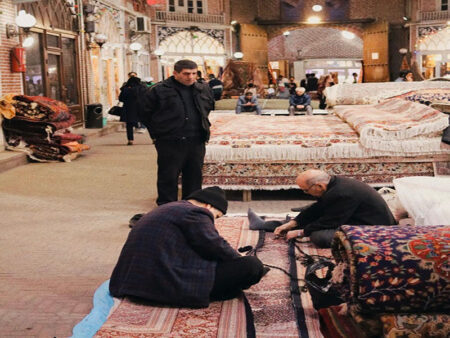
Tabriz carpet market
The great carpet workshops were created in this city during the Safavid era. First-class Iranian weavers came together to weave the best Tabriz hand-woven rugs. In the middle of the Qajar period, Tabriz Persian rugs entered world markets. This boosted the city’s rug weaving industry.
Cecil Edwards, an English author, wrote The Persian Carpet. He wrote about the export of Iran’s rugs and the role of Tabriz merchants. He said, “The trading of this product was in the hands of Tabriz merchants who were well-known and wealthy people. Their business also had branches in Istanbul. They mainly bought goods from Western factories and transported them to Iran through Turkey.”
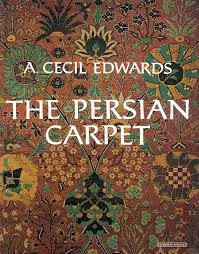
The persian carpet
In the book Rugs and Carpets of the World by Ian Bennett, we come across a theory about Tabriz handmade rug designs during the Safavid era: “a large number of medallion rugs, which were woven in the early years of the 16th century during the reign of Shah Ismail I and Shah Tahmasab, have Islamic designs and animal and human motifs.”
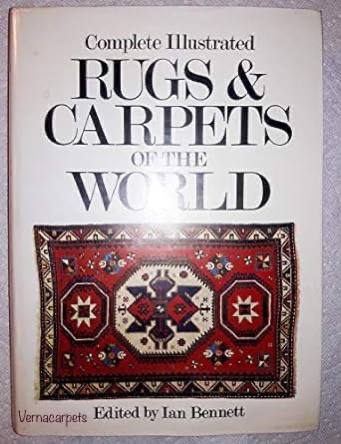
Rugs & Carpets of the world
The author notes that some museum rugs are from Tabriz workshops. Among the important examples said to have been woven in Tabriz rug workshops during this period, the following can be mentioned:
The famous carpet of Ardabil Mosque, which is now kept in the Victoria and Albert Museum in London.
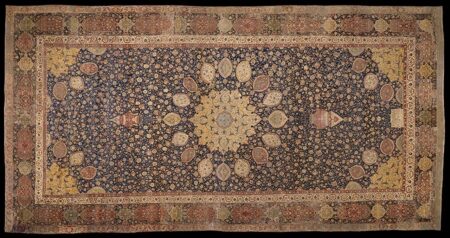
The carpet of Sheikh Safi Ardabil is kept in the Victoria Albert Museum
There is another rug that is related to this mosque and is taken care of at Maison Duveen.
A carpet that belonged to Emperor Charles Quint.
Two very beautiful rugs in the Poldi Museum in Milan, the first of which dates back to 1522 and has the signature of “Ghyas el Din Jami”, and the second of which belongs to the second half of the 16th century.
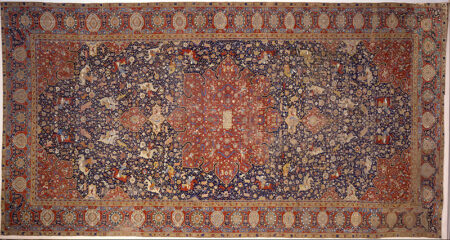
“Ghyas el Din Jami” Tabriz Rug in Poldi Museum in Milan
How to identify Tabriz rugs? How can you tell if a rug is Tabriz? So far in the article, you have noticed the value of Tabriz handwoven rugs. These rugs are famous all over the world. They are kept in the best palaces and museums and by collectors. If you plan to buy Tabriz hand-knotted rugs, learn their traits. They are a type of best Iranian, hand-woven carpet.
Tabriz rugs have short and regular piles compared to other rugs. For this reason, they are lighter than other Iranian hand-knotted carpets.
They have high order and elegance and are finely woven. The density of exquisite Tabriz rugs sometimes reaches over 80 knots in 7 centimeters.
The type of knot in Tabriz hand-woven rugs is the Turkish knot, and this knot is characteristic of Tabriz handmade carpets.
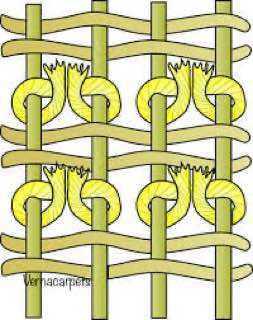
Symmetrical knot
High-quality wool and silk are used for its texture.
They are woven in two wefts, and this makes the rug stronger.
Tabriz rug patterns are very diverse. They often have a medallion in the center, which is decorated with flower motifs around it. But pictorial designs are also available.
The Tabriz rug’s texture has many color variations. Shadows in its empty areas make it look three-dimensional.
Rug weavers in this area use only vertical looms. You will rarely see horizontal looms.
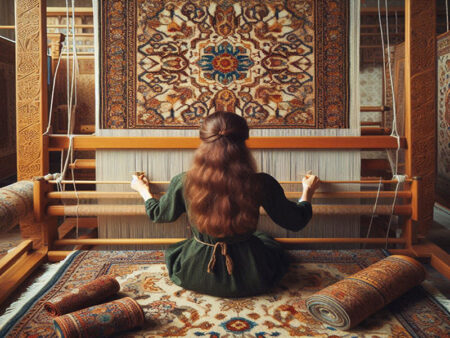
Weaving Tabriz Rug
You may have a question, are Tabriz rugs good? In response, we must say that Tabriz rugs are of good quality. They are made of high-quality materials such as wool and silk. These carpets are woven by the best rug-weaving artists and masters. The rug weavers of Tabriz use the Turkish knot to weave these rugs. It is the best, strongest knot. This is the reason why Persian Tabriz rugs are expensive!
Please read this article:
How to Distinguish Hand-Woven Carpet and Machine-Made Carpet?
Making a handmade Iranian rug may take months or years. First, a beautiful design must be created. Then it will be dyed with excellent colors by experienced dyers. At this stage, it is time to put the knots together like tiny pearls. For a large rug, this process may take 2-3 years.
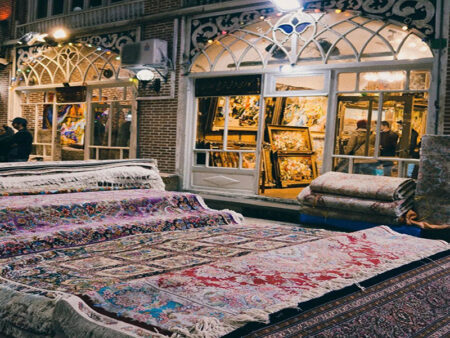
Tabriz rug Bazar
Tabriz rugs have different designs, the most common of which is the fish design. The fish pattern was first woven in Herat, Afghanistan; at that time, Herat belonged to Iran. For this reason, the fish design is also called Herati. The fish design consists of fish that seem to be swimming in a lake.
Some of the other top Tabriz rug patterns are: Nami, Khatibi, Salari, Gonbad, Golestan, Qare baghi and Alia. you can refer to the article Familiarity with Tabriz carpet designs to learn more about these designs.
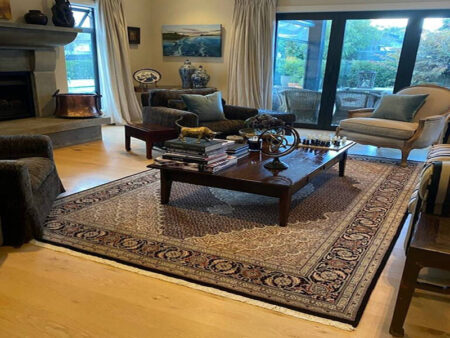
Mahi Tabriz Rug
Tabriz was the first capital of the Safavid period. Safavid kings paid a lot of attention to rug weaving in Iran. It can be claimed that the best antique carpets of Tabriz were woven during this period and after. What separates Tabriz antique rugs from other Iranian antique rugs is the diversity in design, color, and quality. In these carpets, you can see a lot of lace designs in different colors.
Tabriz has endured many events, including Mongol attacks and earthquakes. Despite this, it has kept its carpet-weaving art. In the 19th century, three masters of carpet weaving, Haji Jalili, Kurban Daei, and Sheikh Safi, served Tabriz handmade rugs well.
Haji Jalili’s carpets are among the finest. They have unique pastel colors, great designs, and excellent wool. These rugs are now kept as jewels in museums and by collectors.
You can read this article: Tabriz Haji Jalili Rugs
Tabriz Iranian rugs with their beautiful colors and patterns give an oriental atmosphere to every home. These exquisite rugs are made of the finest wool and are usually decorated with silk. The density of Tabriz hand-knotted carpets varies and ranges from relatively coarse to very fine works of art.
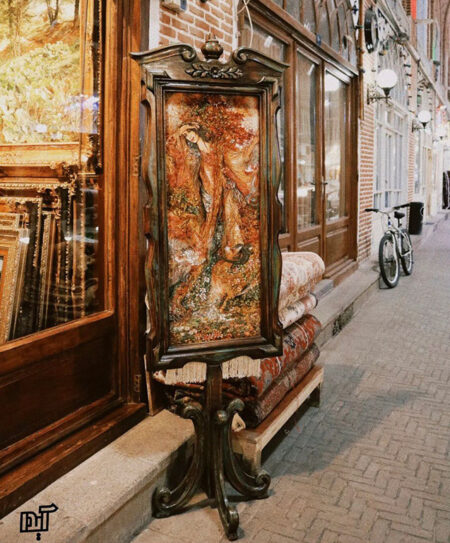
To know Tabriz rugs’ prices, visit our online Vernacarpets collection. With a Tabriz rug, you get a high-quality Iranian tradition seasoned with history. You add an oriental culture to your home. Also, by caring for your rug, you can obtain a valuable Tabriz antique rug in the long run.